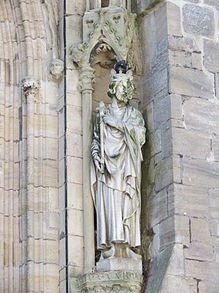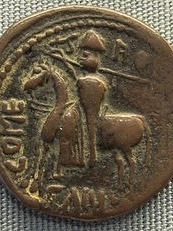Familienstammbaum Snelder - Versteegh » Count Roger I of Sicily (1031-1101)
Persönliche Daten Count Roger I of Sicily
Quelle 1- Er wurde geboren im Jahr 1031 in Hauteville-la-Guichard Normandie France.
- Berufe:
- Duc de Calabre.
- Duc de Calabre, Comte de Sicile et des Pouilles, Count of Sicily, the Norman Count of Sicily from 1071 to 1101.
- Glaube: Christianity.
- Er ist verstorben im Jahr 1101 in Mileto, Vibo Valentia, Calabria, Italia, er war 70 Jahre alt.
- Er wurde beerdigt in Abbey of the Holy Trinity, Mileto, Calabria, Italy.
- Ein Kind von Tancred of Hauteville und Fressenda
Familie von Count Roger I of Sicily
Er hat eine Beziehung mit Eremburga of Mortain.
Kind(er):
Notizen bei Count Roger I of Sicily
https://en.wikipedia.org/wiki/Roger_I_of_Sicily
Roger I (c. 1031 – 22 June 1101), nicknamed Roger Bosso and The Great Count, was a Norman nobleman who became the first Count of Sicily from 1071 to 1101. He was a member of the House of Hauteville, and his descendants in the male line continued to rule Sicily down to 1194.
Roger was born in Normandy, and came to southern Italy as a young man in 1057. He participated in several military expeditions against the Emirate of Sicily beginning in 1061. He was invested with part of Sicily and the title of count by his brother, Robert Guiscard, Duke of Apulia, in 1071. By 1090, he had conquered the entire island. In 1091, he conquered Malta. The state he created was merged with the Duchy of Apulia in 1127 and became the Kingdom of Sicily in 1130.
Roger was the youngest son of Tancred of Hauteville by his second wife Fredisenda.[1] Roger arrived in Southern Italy in the summer of 1057.[2] The Benedictine monk, Geoffrey Malaterra, who compares Robert Guiscard ;and his brother Roger to "Joseph and Benjamin of old," said of Roger:
He was a youth of the greatest beauty, of lofty stature, of graceful shape, most eloquent in speech and cool in counsel. He was far-seeing in arranging all his actions, pleasant and merry all with men; strong and brave, and furious in battle."[3]
In 1057 he shared the conquest of nearly all of Calabria excepting Reggio with his brother Robert.[2] For a time Roger lived like a bandit in his castle of Scalea, near Cosenza.[2] In a treaty of 1062, the brothers divided the conquest so that each was to have half of every castle and town in Calabria.[4]
Roger had first thought of conquering Sicily when he and his brother conquered Calabria.[5] At the time, it was ruled by Muslims and the population was mostly GreekByzantine Christians. The Arab princes had become all but independent of the sultan of Tunis. In May 1061 the brothers crossed from Reggio and captured Messina.[5] After they took Palermo in January 1072, Robert Guiscard, as suzerain, invested Roger as Count of Sicily.[6] Robert retained Palermo, half of Messina, and the north-east portion (the Val Demone).[6] Not till 1085 was Roger able to undertake a systematic conquest.
In March 1086 Syracuse surrendered, and when in February 1091 Noto yielded, the conquest of Sicily was complete.[7] Much of Robert's success had been due to Roger's support. Similarly, when the leadership of the Hautevilles passed to Roger, he supported his nephew Duke Roger against Bohemund I of Antioch, Lando IV of Capua, and other rebels. In return for his uncle's aid against Bohemund and the rebels, the duke Roger surrendered his share in the castles of Calabria to his uncle in 1085, and in 1091 his inheritance in Palermo.
Roger's rule in Sicily became more absolute than that of Robert Guiscard's in Italy. In addition, due to immigration by Lombards and Normans, Latin Christianity gradually replaced that of the Greek Byzantine tradition. At the enfeoffments of 1072 and 1092, no great undivided fiefs were created. The mixed Norman, French and Italian vassals all owed their benefices to the count. No feudal revolt of importance arose against Roger.
In 1091 Roger, in order to avoid an attack from North Africa, set sail with a fleet to conquer Malta. His ship reached the island before the rest. On landing, the few defenders the Normans encountered retreated and the following day Roger marched to the capital Mdina. Terms were discussed with the local qadi. It was agreed that the islands would become tributaries of the count himself and that the qadi should continue to administer the islands. With the treaty many Greek and other Christian prisoners were released, who chanted to Roger the Kyrie eleison. He left the islands with many who wished to join him and so many were on his ship that it nearly sank, according to Geoffrey Malaterra. Maltese legend has it that the Count gave the Maltese their red and white flag by cutting a part of his banner. Mass is said once a year in remembrance of the Count at the Cathedral of Mdina, as a recognition for the Count's role in liberating Maltese Christians from Muslim dominance and rule.
Politically supreme, the count also became master of the insular church. The Papacy, favouring a prince who had recovered Sicily from Greeks and Muslims, in 1098 granted Roger and his heirs the Apostolic Legateship of the island. Roger created new Latin bishoprics at Syracuse, Girgenti and elsewhere, nominating the bishops personally, while he turned the archbishopric of Palermo into a Catholic see. He practiced general toleration towards Arabs and Greeks, even sponsoring the construction of over twelve Greek monasteries in the Val Demone region.[8] In the cities, the Muslims, who had generally secured such rights in their terms of surrender, retained their mosques, their kadis, and freedom of trade; in the country, however, they became serfs. Roger drew the mass of his infantry from the Muslims; Saint Anselm, visiting him at the siege of Capua, 1098, found "the brown tents of the Arabs innumerable". Nevertheless, the Latin element began to prevail, as Lombards and other Italians flocked to the island in the wake of the conquest, and the conquest of Sicily proved decisive in the steady decline of Muslim power in the western Mediterranean from this time.[citation needed]
Roger died at Mileto.
Roger's eldest son, Jordan, predeceased him. Roger's second son, Geoffrey, possibly illegitimate, was a leper with no chance of inheriting.
Roger's first marriage took place in 1062, to Judith d'Évreux.[9] She died in 1076, leaving daughters:
- A daughter, married Hugh of Jarzé (died 1075/6), the first count of Paternò
- Matilda (1062 – before 1094), wife of Robert, Count of Eu and Raymond IV of Toulouse[10]
- Adelisa (died 1096), married in 1083 to Henry, Count of Monte Sant'Angelo
- Emma (died 1120), briefly engaged to Philip I of France; married firstly William VI of Auvergne and secondly Rudolf of Montescaglioso.
In 1077, Roger married a second time, to Eremburga of Mortain,[11] and their children were:
- Mauger, Count of Troina
- Matilda, wife of Ranulf II, Count of Alife
- Muriel (died 1119), married Josbert de Lucy
- Constance
- Felicia, wife of Coloman, King of Hungary
- Violante, married Robert, son of Robert I of Burgundy
- Flandina, married ;Henry del Vasto
- Judith (died 1136), married Robert I of Bassunvilla
Roger's last wife was Adelaide del Vasto, a sister of aforementioned Henry. They married in 1087. Roger and Adelaide's children were:
- Simon of Sicily
- Roger II of Sicily
- Maximilla (Matilda), wife of Conrad II of Italy[12]
Roger's other daughter called Matilda married Guigues III, Count of Albon.
Zeitbalken Count Roger I of Sicily
 Großeltern
Großeltern
 Eltern
Eltern
 Geschwister
Geschwister
 Kinder
Kinder
Abbildung(en) Count Roger I of Sicily
Quellen
- Snelder-Versteegh Web Site, roel snelder, via https://www.myheritage.nl/person-1511710...
Toegevoegd door een Smart Match te bevestigen
Stambomen op MyHeritage
Familiesite: Snelder-Versteegh Web Site
Familiestamboom: 388366452-1
Anknüpfungspunkte in anderen Publikationen
Diese Person kommt auch in der Publikation vor:Über den Familiennamen Of Sicily
- Zeigen Sie die Informationen an, über die Genealogie Online verfügt über den Nachnamen Of Sicily.
- Überprüfen Sie die Informationen, die Open Archives hat über Of Sicily.
- Überprüfen Sie im Register Wie (onder)zoekt wie?, wer den Familiennamen Of Sicily (unter)sucht.
Roel Snelder, "Familienstammbaum Snelder - Versteegh", Datenbank, Genealogie Online (https://www.genealogieonline.nl/stamboom-snelder-versteegh/I507391.php : abgerufen 28. Mai 2024), "Count Roger I of Sicily (1031-1101)".






